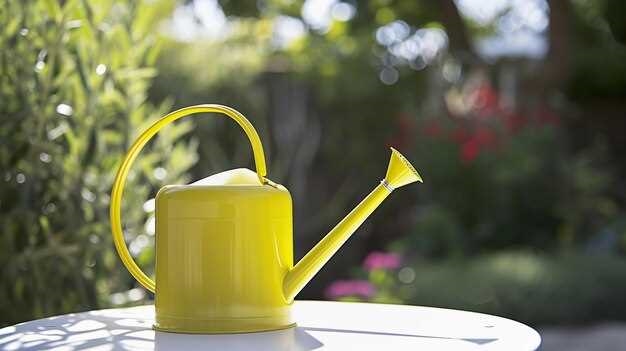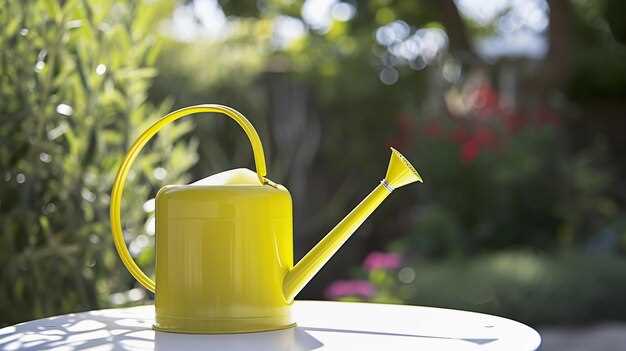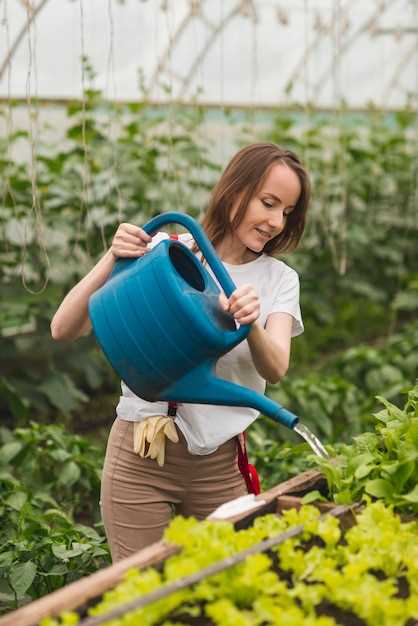

When it comes to nurturing your beloved plants and flowers, employing the appropriate tools is of paramount importance. In this regard, watering cans emerge as a highly advantageous option for tending to your garden. These versatile vessels offer a multitude of benefits that contribute to the overall well-being and flourishing of your green haven.
Enhanced Efficiency: By opting for watering cans, you can significantly optimize the efficiency of your gardening routine. Unlike other watering methods, these vessels allow for a controlled and targeted distribution of water, ensuring that each plant receives the necessary amount of hydration without any wastage. This efficient approach not only saves you valuable time and effort but also conserves water resources, making it a sustainable choice for your gardening endeavors.
Impeccable Precision: Precision is key when it comes to nurturing delicate plants or providing water to specific areas of your garden. Watering cans enable you to exercise precise control over the flow and direction of water, allowing you to cater to the unique needs of each plant. Whether you need to water seedlings, delicate flowers, or potted plants, the fine spout of a watering can ensures that you can deliver water exactly where it is needed, minimizing the risk of overwatering or damaging your green companions.
Furthermore, the ergonomic design of modern watering cans ensures comfortable handling, allowing you to maneuver effortlessly through your garden while maintaining the desired level of precision. With a watering can in hand, you can become the master conductor of hydration, orchestrating the growth and vitality of your plants with finesse.
Environmental Friendliness: In an era where sustainability is a pressing concern, incorporating watering cans into your gardening routine is a small yet significant step towards a greener future. By utilizing these eco-friendly vessels, you reduce your reliance on energy-consuming alternatives such as sprinkler systems or hosepipes. Additionally, the controlled water distribution provided by watering cans minimizes runoff and evaporation, ensuring that every drop of water is utilized efficiently and responsibly.
By embracing the efficiency, precision, and sustainability offered by watering cans, you not only enhance the health and beauty of your garden but also contribute to the preservation of our precious natural resources. So, why not embrace this simple yet powerful tool and embark on a journey towards a flourishing and environmentally conscious garden?
Water Conservation: Preserving a Precious Resource
Water conservation plays a crucial role in safeguarding our limited and valuable water resources. By implementing sustainable practices and utilizing efficient methods, we can ensure the preservation of this precious resource for future generations.
The Importance of Water Conservation
Conserving water is essential for maintaining the delicate balance of our ecosystems and sustaining life on Earth. With increasing population growth and climate change, the demand for water is steadily rising, making it imperative to adopt measures that promote responsible water usage.
Efficient Watering Techniques
One effective way to conserve water in gardening is by using watering cans. These versatile tools allow for precise water distribution, ensuring that only the necessary amount of water reaches the plants’ roots. By avoiding excessive watering, we can prevent water wastage and promote healthier plant growth.
- Watering cans provide a targeted approach, allowing gardeners to water specific areas without wasting water on non-essential areas.
- They enable gardeners to control the flow of water, ensuring that plants receive just the right amount needed for optimal growth.
- Using watering cans also reduces the risk of overwatering, which can lead to root rot and other plant diseases.
Sustainable Gardening Practices
Water conservation goes hand in hand with sustainable gardening practices. By incorporating eco-friendly techniques, we can minimize water usage and create a more resilient and environmentally friendly garden.
- Collecting rainwater in barrels or tanks provides a free and abundant source of water for plants, reducing reliance on treated water.
- Implementing mulching techniques helps retain moisture in the soil, reducing the need for frequent watering.
- Choosing native plants that are adapted to the local climate and require less water can significantly reduce water consumption in the garden.
- Regularly maintaining irrigation systems and fixing leaks promptly can prevent unnecessary water loss.
By embracing water conservation practices and utilizing watering cans, we can make a positive impact on our environment and ensure the sustainable use of this precious resource. Let us all play our part in preserving water for a greener and more sustainable future.
Enhanced Plant Growth: Providing the Right Amount of Water
Optimizing plant growth requires a delicate balance of providing plants with the appropriate amount of water. By ensuring plants receive the correct level of hydration, gardeners can promote healthier and more robust growth. This section explores the significance of providing plants with the right amount of water and how using watering cans can contribute to enhanced plant growth.
Weed Control: Targeted Watering for Healthy Plants
In the realm of gardening, maintaining a weed-free environment is crucial for the optimal growth and health of your plants. One effective method to achieve this is through targeted watering. By directing water precisely to the plants you want to nourish, you can minimize the growth of unwanted weeds and ensure the vitality of your garden.
Enhancing Plant Health
Targeted watering allows you to focus on specific areas of your garden, providing the necessary moisture directly to your plants. This approach ensures that your plants receive the optimal amount of water, promoting their overall health and growth. By avoiding excessive watering or watering the entire garden indiscriminately, you can prevent the proliferation of weeds that thrive in moist environments.
Minimizing Weed Growth
Watering cans enable you to precisely deliver water to the base of your plants, avoiding unnecessary contact with the surrounding soil. This targeted approach reduces the availability of moisture for weed seeds, inhibiting their germination and growth. By minimizing the water supply to unwanted plants, you can effectively control weed growth and maintain the aesthetic appeal of your garden.
In addition to preventing weed growth, targeted watering also conserves water by minimizing wastage. Unlike sprinkler systems or hoses, watering cans allow you to control the amount of water used, ensuring that only the necessary amount is applied to your plants. This sustainable approach not only benefits your garden but also contributes to the conservation of water resources.
In conclusion, targeted watering with watering cans is a valuable technique for weed control and promoting healthy plant growth. By focusing on specific areas and avoiding excessive watering, you can minimize weed growth and enhance the overall health of your garden. Incorporating this practice into your gardening routine not only ensures efficiency and precision but also contributes to the sustainability of your gardening practices.
Disease Prevention: Minimizing the Spread of Pathogens
Ensuring the health and vitality of your garden goes beyond the efficiency, precision, and sustainability provided by watering cans. A crucial aspect of maintaining a thriving garden is disease prevention, which involves minimizing the spread of harmful pathogens. By implementing proper practices and techniques, you can safeguard your plants from diseases and promote their overall well-being.
Understanding Pathogens and Their Impact
Pathogens, often invisible to the naked eye, are microorganisms that can cause diseases in plants. These harmful agents include bacteria, fungi, viruses, and nematodes, which can infect various parts of a plant, such as its roots, leaves, stems, or fruits. When left unchecked, pathogens can weaken plants, hinder their growth, and even lead to their death. Therefore, it is crucial to take proactive measures to minimize their spread and protect your garden.
Implementing Disease Prevention Strategies
Preventing the spread of pathogens requires a combination of careful planning, regular monitoring, and timely intervention. Here are some effective strategies to minimize the risk of diseases in your garden:
| 1. Crop Rotation | Rotate your crops each season to disrupt the life cycles of pathogens and reduce their buildup in the soil. This practice helps prevent the recurrence of diseases and promotes a healthier growing environment. |
| 2. Sanitation | Maintain cleanliness in your garden by removing and disposing of any infected plant debris. Regularly clean your gardening tools to prevent the transmission of pathogens from one plant to another. |
| 3. Proper Watering | Avoid overwatering, as excessive moisture can create favorable conditions for pathogens to thrive. Instead, water your plants at their base using a watering can, ensuring that the leaves remain dry to minimize the risk of fungal infections. |
| 4. Disease-Resistant Varieties | Select and cultivate plant varieties that are known for their resistance to common diseases in your region. These varieties have built-in genetic traits that make them less susceptible to pathogens, providing an added layer of protection. |
| 5. Biological Controls | Consider using natural predators, beneficial insects, or microbial agents to control pests and diseases in your garden. These biological controls can help suppress the population of harmful pathogens without resorting to chemical interventions. |
By incorporating these disease prevention strategies into your gardening routine, you can minimize the spread of pathogens and create a healthier environment for your plants to thrive. Remember, a proactive approach to disease prevention is key to maintaining the long-term vitality and productivity of your garden.
Cost-Effective Solution: Saving Money on Water Bills
When it comes to maintaining a lush and thriving garden, water is an essential resource. However, the cost of watering your plants can quickly add up, especially if you rely on traditional methods. This section explores how using watering cans can be a cost-effective solution, helping you save money on your water bills without compromising the health and beauty of your garden.
Efficiency in Water Usage
One of the key advantages of using watering cans is their efficiency in water usage. Unlike other watering methods that may result in water wastage, watering cans allow for precise control over the amount of water applied to each plant. By targeting the roots directly, you can ensure that water is not wasted on areas where it is not needed, ultimately reducing your water consumption and lowering your water bills.
Precision and Customization
Watering cans provide a level of precision and customization that is unmatched by other watering techniques. With the ability to adjust the flow and direction of water, you can tailor your watering to the specific needs of each plant. This precision ensures that each plant receives the right amount of water, promoting healthy growth and minimizing the risk of overwatering. By avoiding water runoff and evaporation, you can maximize the effectiveness of your watering efforts and save money on unnecessary water usage.
By incorporating watering cans into your gardening routine, you can enjoy the benefits of a cost-effective solution that helps you save money on water bills. With their efficiency, precision, and customization capabilities, watering cans offer a sustainable and economical way to keep your garden thriving while reducing your environmental impact.
Eco-Friendly Gardening: Reducing Environmental Impact
Gardening practices that prioritize the well-being of the environment are becoming increasingly important in today’s world. By adopting eco-friendly gardening techniques, individuals can contribute to reducing their environmental impact and promoting sustainability. This section explores various strategies and approaches that can be implemented to create a more eco-friendly garden.
1. Conservation of Water
One of the key aspects of eco-friendly gardening is the efficient use of water resources. By employing water-saving techniques such as using watering cans instead of hosepipes, gardeners can minimize water wastage and ensure that plants receive the necessary hydration without excessive consumption. This approach not only conserves water but also reduces the strain on local water supplies.
2. Organic Pest Control

Another important aspect of eco-friendly gardening is the use of organic pest control methods. Instead of relying on chemical pesticides that can harm beneficial insects and contaminate the soil, gardeners can opt for natural alternatives. These may include introducing beneficial insects, using companion planting techniques, or creating physical barriers to deter pests. By avoiding the use of harmful chemicals, gardeners can maintain a healthy ecosystem and protect the environment.
- Implementing companion planting techniques
- Introducing beneficial insects
- Creating physical barriers
By adopting eco-friendly gardening practices, individuals can make a positive impact on the environment. Conserving water, using organic pest control methods, and promoting a healthy ecosystem are just a few ways to reduce the environmental impact of gardening. By embracing these strategies, gardeners can create sustainable and thriving gardens while contributing to a greener future.





